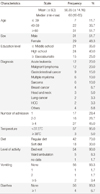Abstract
Purpose
The purpose of the study was to evaluate the accuracy of two different fluid intake measurement methods (fluid only vs. all dietary intake) in measuring fluid balance compared to body weight change among patients with cancers.
Methods
A total of 60 cancer patients in an urban cancer center in South Korea participated in the study. Adult patients who were over 18 years old; having 24-hr I&O order; and taking either normal regular diet or soft blend diet were included. Demographic information and disease related information were also gathered. The data were analyzed using SPSS 18.0 program.
Results
Measuring 'fluid only' for oral intake was a more accurate measure than measuring 'all dietary intake' (p=.026 vs. p=.094). Both methods had positive correlations with the amount of weight change (r=.329, p=.010; r=.303, p=.019). Measuring body weight was a more accurate and efficient way of evaluating the fluid balance than 24 hr cumulative I&O.
Figures and Tables
References
1. Wise LC, Mersch J, Racioppi J, Crosier J, Thompson C. Evaluating the reliability and utility of cumulative intake and output. J Nurs Care Qual. 2000. 14(3):37–42.

2. Alexander L, Allen D. Establishing an evidence-based inpatient medical oncology fluid balance measurement policy. Clin J Oncol Nurs. 2011. 15:23–25.

3. Yang YH, Choi-Kwon S, Kim EK, Sung IS. A study of the fluid balance of the patients on soft diets. J Nurs Acad Soc. 1996. 26:688–696.

4. Mank A, Semin-Goossens A, Lelie J, Bakker P, Vos R. Monitoring hyperhydration during high-dose chemotherapy: Body weight or fluid balance? Acta Haematol. 2003. 109:163–168.

5. Lee HR, Choi CJ, Park OJ, Kim YS, Choi KO, Kim KS, et al. Medical Surgical Nursing. 2008. 6 ed. Seoul: SooMoonSa.
6. Perry AG, Potter PA. Clinical Nursing Skills and Techniques. 2010. 7 ed. St. Louis, MO: Mosby.
7. Lee KY, Kim DW, Kim SY. Human Physiology. 2009. 4 ed. Seoul: HyunMoonSa.
8. Won JS, Yoo JH, Paik HJ, Son YH, Yang SH. Fundametals of Nursing Skills. 2007. 4 ed. Seoul: HyunMoonSa.
9. Choi SK, Yang YH, Jung Y. A study on fluid intake and output measurements. J Nurs Acad Soc. 1995. 25:88–98.

10. Son JT, Jang EH, Ha NS, Lee HJ, Yang JH, Kim HM, et al. Fundamental Nursing. 2006. Seoul: HyunMoonSa.
11. Kang ES, Park KH, Jeong MJ, Ju NK, Song HJ. Improvement activity for accurate fluid intake and output measurement. QA Fall Conf Korea Univ. 2005. 2:238–239.
12. Meiner SE. Fluid balance documentation: A case study of daily weight and intake/output omissions. Geriatr Nurs. 2002. 23:46–47.
13. Daffurn K, Millman KM, Lum M, Crispin C, Ince L. Fluid balance charts: Do they measure up? Br J Nurs. 1994. 3:816–820.

14. Eastwood GM, Nsg GD. Evaluating the reliability fo recorded fluid balance to approximate body weight change in patients undergoing cardiac surgery. Heart Lung. 2006. 35:27–33.

15. Chung BD, Parekh U, Sellin JH. Effect of increased fluid intake on stool output in normal healthy volunteers. J Clin Gastroenterol. 1999. 28(1):29–32.

16. Elgart HN. Assessment of Fluid and Electrolytes. AACN Clin Issues. 2004. 15:607–621.
17. Lee CK, Kim YK, Suh MH, Lee KM, Lee JE, Im HY. Research on fluid balance measurement. Clin Res Samsung Med Ctr. 2010. 1:47–50.
18. Fowles ER, Sterling BS, Walker LO. Measuring dietary intake in nursing research. CJNR. 2007. 39:146–165.
19. Lee SJ, Song WS, Yoon SY. Comparison of measurement of intake and output with body weight change in patients with lobectomy lung surgery. Clin Res Samsung Med Ctr. 2004.
20. Reid J, Robb E, Stone D, Bowen P, Baker R. Improving the monitoring and assessment of fluid balance. Nurs Times. 2004. 100:36–37.




 PDF
PDF ePub
ePub Citation
Citation Print
Print






 XML Download
XML Download